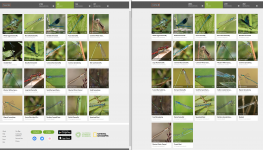opisska
rabid twitcher

Yesterday, I had to drive 200 kms to get my second Pfizer shot and as the direction was Bialystok, we thought it's a good opportunity to add Aquatic Warbler to our yearlist - which we easily did at their most famous spot at Bagno Lawki. The following acoustic night search for Baillon's crake turned out to be pointless as expected, but it gave us the opportunity to look for some insect in the morning - well, we also looked in the evening, but the Dragnoflies wouldn't cooperate and the "best" photo looks like this - Emerald Dragonflies (Family Corduliidae) .
In the morning I first jumped the gun a bit after seeing a Damselfly with prominently blue eyes and thus declaring it Blue-eye. Eventually I realized that the body pattern was completely wrong and it was a good old White-legged - White-legged Damselfly (Platycnemis pennipes) - ... but why is Blue-eye called so, if its blue eyes aren't that unusual?
We then paid a visit to a marsh near Zajki, the central point of which is a structure that we jovially call "the mosquito hide" - but the mosquitoes were actually not that bad in the daytime (while they were absolutely insufferable in the night visit for the crakes). This has proven a good idea, because the place was rather rich in Large White-faced Darters - Large White-faced Darter (Leucorrhinia pectoralis) . That was basically the last Odonata species that we did not have which is commonly reported in Poland these days on ornitho.pl, so now the hard part begins ... or the wait for more species to start flying around?
Then the trip abruptly ended, because unlike the first dose which I did not feel at all, the second one got me good and mostly lost the ability to stand, not to mention to walk somewhere.
Of the 62 species reported in Poland on iNaturalist we have now seen 28 (even though not all necessarily in Poland).
In the morning I first jumped the gun a bit after seeing a Damselfly with prominently blue eyes and thus declaring it Blue-eye. Eventually I realized that the body pattern was completely wrong and it was a good old White-legged - White-legged Damselfly (Platycnemis pennipes) - ... but why is Blue-eye called so, if its blue eyes aren't that unusual?
We then paid a visit to a marsh near Zajki, the central point of which is a structure that we jovially call "the mosquito hide" - but the mosquitoes were actually not that bad in the daytime (while they were absolutely insufferable in the night visit for the crakes). This has proven a good idea, because the place was rather rich in Large White-faced Darters - Large White-faced Darter (Leucorrhinia pectoralis) . That was basically the last Odonata species that we did not have which is commonly reported in Poland these days on ornitho.pl, so now the hard part begins ... or the wait for more species to start flying around?
Then the trip abruptly ended, because unlike the first dose which I did not feel at all, the second one got me good and mostly lost the ability to stand, not to mention to walk somewhere.
Of the 62 species reported in Poland on iNaturalist we have now seen 28 (even though not all necessarily in Poland).




